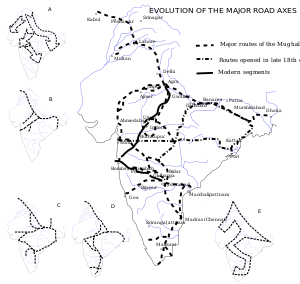Grand Trunk Road
The Grand Trunk Road (abbreviated to GT Road in common usage) is one of South Asia's oldest and longest major roads. For several centuries, it has linked the eastern and western regions of the Indian subcontinent, running from Bengal, across north India, into Peshawar in Pakistan.
Route
Today, the Grand Trunk Road remains a continuum that covers a distance of over 2,500 km.
Bangladesh
The Grand Trunk road begins at Sonargaon in the Narayanganj district of Bangladesh.
India
Within India, it passes through Kolkata, Asansol, Amritsar, Varanasi, Allahabad, Kanpur, Agra, Delhi, Kurukshetra and Ambala. Within India, the major portion of the road, the stretch between Kanpur and Kolkata, is known as NH-2 (National Highway - 2), the stretch between Kanpur and Delhi is called NH-91 (National Highway - 91), and that between Delhi and Wagah, at the border with Pakistan, is known as NH-1.
Pakistan
The Grand Trunk Road enters Pakistan on the Wagah border and continues through Lahore and Rawalpindi, and then Attock and Peshawar, across the Indus River.
History

Recent research indicates that during the time of the Maurya empire, overland trade between India and several parts of western Asia and the Hellenic world went through the cities of the north-west, primarily Taxila (located in present day Pakistan)(see inset in map). Taxila was well connected by roads with other parts of the Maurya empire. The Mauryas had built a highway from Taxila to Pataliputra (present-day Patna in Bihar, India).

In the 16th century, a major road running across the Gangetic plain was built afresh by Pashtun emperor Sher Shah Suri, who then ruled much of northern India. His intention was to link together the remote provinces of his vast empire for administrative and military reasons. The Sadak-e-Azam ("great road") as it was then known, is universally recognized as having been the precursor of the Grand Trunk Road.
The road was initially built by Sher Shah to connect Agra, his capital, with Sasaram, his hometown. It was soon extended westward to Multan and eastward to Sonargaon in Bengal (now in Bangladesh). While Sher Shah died after a brief reign, and his dynasty ended soon afterwards, the road endured as his outstanding legacy. The Mughals, who succeeded the Suris, extended the road westwards: at one time, it extended to Kabul in Afghanistan, crossing the Khyber pass. This road was later improved by the British rulers of colonial India. Renamed the "Grand Trunk Road" (sometimes referred to as the "Long Walk"), it was extended to run from Calcutta to Peshawar and thus to span a major portion of British India.
Over the centuries, the road, which was one of the most important trade routes in the region, facilitated both travel and postal communication. Even during the era of Sher Shah Suri, the road was dotted with caravansarais (highway inns) at regular intervals, and trees were planted on both sides of the road to give shade to the passers-by.The road was well planned, with milestones along the whole stretch. Some of these milestones can still be seen along the present delhi ambala highway. On another note, the road also facilitated the rapid movement of troops and of foreign invaders. It expedited the looting raids, into India's interior regions, of Afghan and Persian invaders and also facilitated the movement of British troops from Bengal into the north Indian plain.
The Grand Trunk Road continues to be one of the major arteries of India and Pakistan. The Indian section is part of the ambitious Golden Quadrilateral project. For over four centuries, the Grand Trunk Road has remained "such a river of life as nowhere else exists in the world".[1]
New Grand Trunk Road
A new Grand Trunk Road, also called the National Highway 5 or N5, has been built in Pakistan. It begins in the port city of Karachi located in Sindh province and stretches north to Thatta, Hyderabad, and Moro before crossing into Punjab province where it passes through Multan, Sahiwal, Lahore, Gujranwala, Gujrat, Jhelum and Rawalpindi. In Rawalpindi, it turns eastwards and passes Attock before crossing the Indus River into NWFP province where is passes through Nowshera, Peshawar before reaching the border town of Torkham crossing into Afghanistan.
See also
- National Highway Authority
- National Highways of Pakistan
- Motorways of Pakistan
- Expressways of India
- National Highways Development Project
Literature
- Farooque, Abdul Khair Muhammad (1977), Roads and Communications in Mughal India. Delhi: Idarah-i Adabiyat-i Delli.
- Weller, Anthony (1997), Days and Nights on the Grand Trunk Road: Calcutta to Khyber. Marlowe & Company.
- Kipling, Rudyard (1901), Kim. Considered one of Kipling's finest works, it is set mostly along the Grand Trunk Road. Free e-texts are available, for instance here.
External links
Notes
- ^ A description of the road by Kipling, found both in his letters and in the novel "Kim". He writes: "Look! Brahmins and chumars, bankers and tinkers, barbers and bunnias, pilgrims -and potters - all the world going and coming. It is to me as a river from which I am withdrawn like a log after a flood. And truly the Grand Trunk Road is a wonderful spectacle. It runs straight, bearing without crowding India's traffic for fifteen hundred miles - such a river of life as nowhere else exists in the world."
